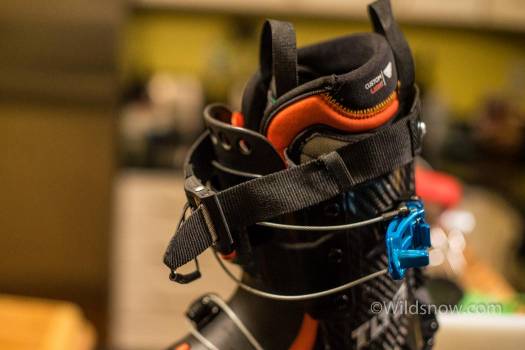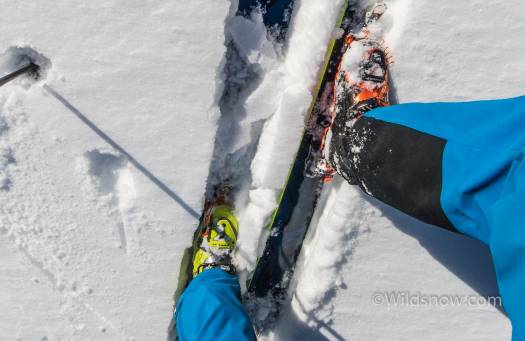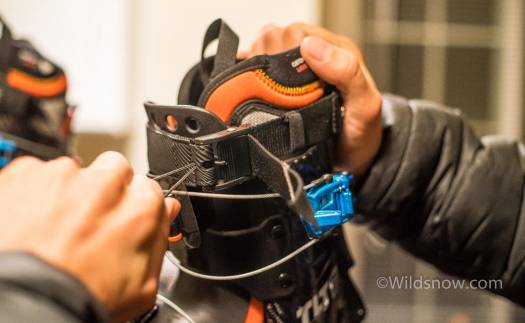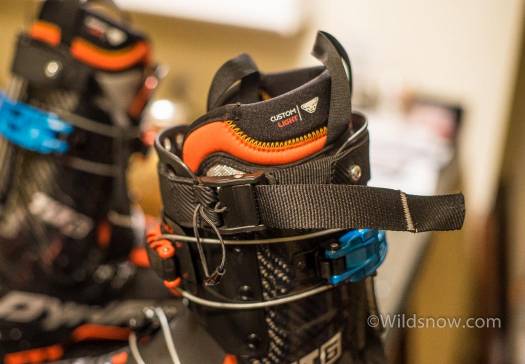Shop for Dynafit TLT6 ski touring boots.
We covered the differences between the 2014-2015 Dynafit TLT6 (Green version), as well as the 2015-2016 (Black version) in this post. As with all our gear-nerding on Wildsnow, it’s in depth, and has a ton of good info. However, the workbench can only tell you so much. I decided buckle one of each model on my pedes and ski them for a day.
To summarize: The Black version has a lower shell (scaffo-shoe) that is made out of Pebax, while the older boot has a lower shell made out of Grilamid. The two plastics are very similar, however the new Pebax is perhaps slightly less stiff, and harder for a bootfitter to heat-punch. The new shell also has slightly more width in the forefoot, and a slightly higher instep, making it feel significantly more roomy. The new boot also has a cam-buckle power strap, rather than the traditional Velcro strap of the older, green boot. This test was performed with two “CL Custom Light” liners, which are the lighter version that we prefer. As pointed out here by reader Greg, the heavier CR liner can add some downhill performance and perhaps a snugger fit (depending on what insoles and other boot fitting tweaks you do.)
A few days ago I did a few laps in our local Colorado backcountry wearing the old green boot on my left foot, and the newer black boot on my right foot. For simplicity and comforts sake, I wore the same (new) liner in both boots, with my custom insoles. I did not heat-mold the liners. The boots were both size 27.5. The black boots were entirely stock, straight from the box. However, the older green boots have been moderately heat-punched at the forefoot, and the lower buckle has been replaced with one that rides on top of the shell instead of to the side — not something that would change downhill skiing performance. Although it was only a day of skiing, I encountered a variety of conditions, and it was a good test.
The first thing I noticed is that the 2015-2016 black boot feels great on my foot, straight out of the box, with no heat-molding. The 2014-2015 green boot felt comfortable as well, but even though it has been heat-punched significantly, it still felt lower volume than the new boot. I was surprised at how much of a difference I could feel, although the new shell is only a few millimeters wider (shows you how sensitive your feet are to small variations). This is excellent, as it means a more comfy, warmer boot, without boot-fitting chores common to the former TLT6 lasting.
Skinning in the boots, they feel quite similar. The new power strap is super easy to adjust with gloves, and can be cranked down much tighter than a traditional Velcro strap. However, the strap doesn’t loosen quite as much as the old Velcro strap (unless you completely undo it). This made the new boots have slightly less range of motion when skinning, when the power straps and buckles were loosened. However, to have comfort and control when skinning, I don’t loosen the Velcro strap entirely, which negates the difference. If you like your boots loosy-goosy when touring, you will notice a slight difference. If you remove the power strap, as many uphill-oriented TLT6 owners do, the difference is irrelevant.
On the transition, the new power strap design really shined. The Velcro power strap has always seemed like an afterthought on the TLT6 boots. Velcro straps are fussy, hard to use with gloves, get gummed up with ice, and drag in the snow when they are undone. Without the power strap, the TLT6 transition is faster than almost anything else. However, the fiddling with the Velcro almost negates the advantage. The newer power strap is significantly faster, can be easily operated with gloves, and gets super tight. Well done.

The 2015 TLT6 powerstrap loosened. Nice and trim. The grey bartack blocks the cam from coming all the way off the strap, unless it is pulled really had.
On the descent, the boots felt nearly identical. I did feel that the older, green boots are slightly stiffer. This would make sense, with the Grilamid vs. Pebax plastic. However, the difference was so subtle that I barely could tell, and it could have been more a factor of the difference of fit than the plastic.
In conclusion, with the exception of the fit, the differences between the two boots are quite subtle. Without wearing both on the same tour, I doubt I would be able to tell the difference between the two. In my opinion, if you already have a pair of TLT6 P boots, there’s no reason to upgrade. The improved fit can easily be achieved with heat-punching, rather than shelling out for a new pair. However, the wider fit will be wonderful for the majority of people purchasing new boots, as they will fit better out of the box, and be warmer. The new power strap is awesome, and makes changeovers quite a bit faster and less hassle. I wonder if Dynafit will be selling it individually? I’d put it on all three dozen pairs of boots in my quiver.
Shop for Dynafit TLT6 ski touring boots.
Louie Dawson earned his Bachelor Degree in Industrial Design from Western Washington University in 2014. When he’s not skiing Mount Baker or somewhere equally as snowy, he’s thinking about new products to make ski mountaineering more fun and safe.



